This week, learners reflected on our environment, continued our appreciation for trees, and brainstormed what it would look like if the world around us was nurtured and cared for.
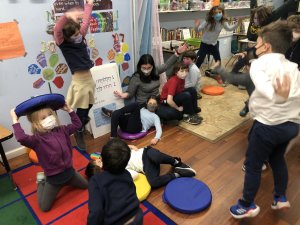
Following the celebration of Tu Bishvat (the Jewish new year of trees) last Monday, the Garinim (kindergarteners) delved into an exploration of people’s relationship with trees and other parts of creation. We started by building the Jewish creation story day by day out of felt: day 1 – the separation of light and dark; day 2 – the separation of sky water and seawater; day 3 – the separation of dry land and grass from the water; day 4 – the sun, moon, and stars; day 5 – birds and fish; and day 6 – animals, creepy crawlers, and people. We wondered why it was in this order and how those created in the later days depend on what was created before them.
Would it be possible for humans to be created before plants? Why or why not?
- No, because people came from animals.
- Humans couldn’t exist without plants and trees to breathe and other animals to eat.
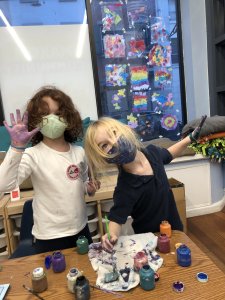
With the creation story in mind, we then acted out the text of God showing the first human all of the trees and other creations in Gan Eden (the Garden of Eden). God said, “See my works, how beautiful and praiseworthy they are. And everything that I created, I created it for you. Be careful not to spoil or destroy my world – for if you do, there will be nobody after you to repair it” (Torah Temimah on Ecclesiastes 7.13).
Why did God single out the trees from all of the beautiful creations in the garden?
- Because it’s close to the trees’ birthday (Tu B’Shevat was Monday!).
- Because trees keep us alive.
- Trees are part of the water cycle, they give us oxygen to breathe.
- Trees help the Earth!
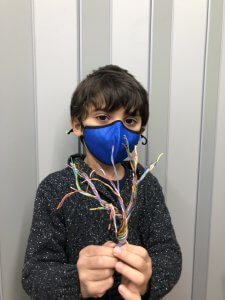
With God’s warning for people to take care of Gan Eden in mind, we read The Lorax by Dr. Seuss. Kiddos found a lot of similarities between God’s warning to people and the Lorax’s warnings to the Once-ler. The Once-ler ignored the Lorax, and ultimately destroyed the Lorax’s world – the trees, birds, fish, animals, clean air, and green grass were gone by the end of the story, maybe irreparably lost.
The Garinim commended the Lorax for not just getting angry at the Once-ler, but also for never giving up and continuing to ask the Once-ler to treat his world better, all the way up until the last tree was cut down. What are some things we can do to take good care of our world?
- Water and feed plants.
- Plant new seeds.
- Give food to animals.
- Make homes for animals.
- Help stray animals find places to live.
- Support no-kill animal adoption centers.
- Don’t cut down trees.
Our kiddos asserted that God, Mother Nature, and lots of people helped make the world a beautiful place for us to live in; it’s our job to keep it that way for everyone coming after us!
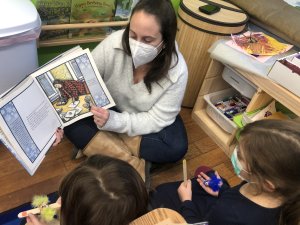
The Shorashim (1st and 2nd graders) started the week with a trip to Rittenhouse Square where we took a moment to observe our surroundings.

Kids pondered the following:
- What are things around us that you find praiseworthy?
- Trees
- Tree roots
- Why are trees so important?
- Breathing/air
- Pretty
- Big part of ecosystem
We then challenged kids to be silent for one minute to really listen to the sounds around us, a semi difficult feat.
- Can you hear the earth calling to you? What is it saying? What do you observe?
- Trees are waving
- Dogs! / animals
- Cars
- What are things in Rittenhouse that seem uncared for?
- People stepping on the tree roots
- Liter
- Dirty fountain
- What are things we could do to care for it?
- Pick up trash
- Put signs up to not step on the roots
- More public trash cans
We then explored the Honi Hama’agel (Honi the circle maker) text from Talmud Bavli Ta’anit 23a, “Honi was distressed that there was no water to help the trees grow in his town. He drew a circle, stood inside it, and cried out to God, “I am not leaving this circle until you have mercy on your children.” Rain began to fall. Honi’s students ran to him and said, “Master, we’re worried this tiny bit of rain only came so you could leave the circle you drew.” Honi replied, “I didn’t pray to be released from my vow, but for our cisterns, caves, and stores of water to be filled.” The biggest rain drops that he had ever seen began to fall from the sky. Then one day, Honi was journeying on the road and he saw a man planting a carob tree. He asked, “How long does it take [for this tree] to bear fruit?” The man replied: “Seventy years.” Honi then further asked him: “Are you certain that you will live another seventy years?” The man replied: “I found [already grown] carob trees in the world; as my forefathers planted those for me so I too plant these for my children.”
We had some really meaningful conversations with the Shorashim about Jewish traditions and some problems that are happening in the world.
- What is circular in our world?
- Planets
- Earth
- Fruits
- Rain
- Our lives
- Plant cycle
- Years
- What is circular in Jewish tradition?
- Kippah
- Challah for High Holy Days
- Pomegranates
- Life cycles
- What are things you do when you have a problem that you don’t have an easy way to solve?
- Write a story about your experience
- Talk about it with friends/family
- Watch a show/read a book
- We can’t solve the pandemic but we can wear masks
- What are problems we have in our world that there isn’t an obvious answer to?
- Climate change
- Covid
- Death
- Pets dying early
For Shulchanot Avodah, kids were particularly excited about Honi madlibs, making Pointillistic/Q-tip tree painting, and hiding the Hebrew word for “tree” or their Hebrew name somewhere in the tree.
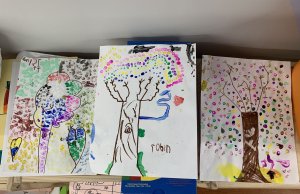
Kiddos also enjoyed a Before/After project where they draw a line down the middle of paper and on the left side, kiddos create a image/scene where something is not being cared for and then on the other side of the paper, kiddos draw what it looks like when it is nurtured and cared for.
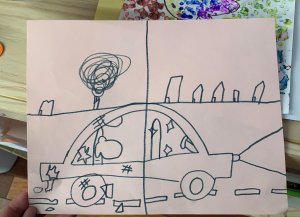
This week, Nitzanim (3rd-5th grade) explored the traditions of Tu B’Shevat with classic Jewish tales told around this holiday: the stories of Honi Hama’agel. Nitzanim performed a mini play about Honi drawing a circle in the ground to demand God to send rain for the dying crops and trees! The kiddos gave lively performances of this ancient tale.

We also reviewed the story of how Honi came across a man planting a carob tree. Honi questioned why he was planting it, since it would take seventy years to fully grow. The man told Honi that he was not planting it for himself, but for those who come after him, just as his forefathers planted carob trees 70+ years ago.
Here are some metaphorical “trees,” which someone who came before us created for our benefit, that we see in our lives:
- The acts of Martin Luther King Jr.
- A crystal that was passed down from great grandparents
We also discussed what “seeds” we want to plant for those who come after us:
- Apple tree
- Protecting the environment – my dad went to inspect the condition of coral reefs in the ocean
The tradition of planting trees for generations to come was imagined as a circle of growing. We benefit from those who planted trees before us, who benefited from trees planted before them, and we have the responsibility to keep the circle or cycle going.
This week we’re starting to sculpt the items that are going on out Tu Bishvat seder plates. As kiddos continue to imagine and plan out what foods or objects represent them and their place in the world, they’ve begun to bring these ideas to life. These are some super creative and introspective kiddos!
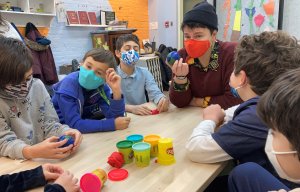
Next week, learners will explore the shema and its significance in Jewish tradition. Kiddos will create their own slogan or motto for themselves, as the shema is often the motto for Judaism, and more!
